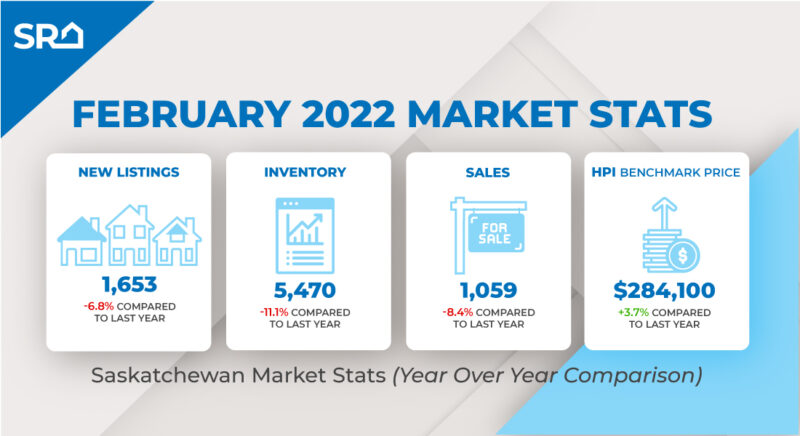FEBRUARY SALES EASE OVER RECORD LEVELS
March 03, 2021
For immediate release:
February sales in the province reached 1,059, an eight per cent decline relative to last year. While the year is starting out with sales that have slowed compared to last year, it is important to note that housing demand continues to remain strong as levels are over 22 per cent higher than what we typically see at the start of the year and nearly 40 per cent higher than average levels recorded throughout the 2015–2020-time frame.
While there have been some signs of improving new listings relative to sales, inventory levels remained lower than levels we traditionally see in the market and the months of supply averaged just over five months. The five months of supply in February is slightly lower than levels expected at this time of year.
“There is a significant amount of uncertainty weighing on the economy. While this could have some impact on demand, supply levels are still low providing some cushion should demand taper further. Conditions also vary significantly based on location, property type and price range because real estate is very local,” said Saskatchewan REALTORS® Association CEO Chris Guérette.
Most of the decline in sales was driven by pullback in the detached sector. However, some of this could be related to the lower inventory levels. Detached inventories in February were 3,643 across the province 30 per cent below 10-year averages and the lowest the market has seen since 2010.
“Last month we started to raise an alarm bell about inventory levels in Saskatchewan,” said Guérette. “Now that we’re two months into the market, that dip in inventory levels being the lowest we’ve seen since 2010 is concerning. That’s why we’re working harder than ever to build a fuller picture of Saskatchewan’s housing continuum so we can identify where the gaps are and build smartly and collaboratively for growth.”
Benchmark prices in the province have remained stable over the past several months, but on a year-to-date basis remain over five per cent higher than last year’s levels. If the inventory can better meet demand as we move through the spring, it should support more stability in prices this year.
# # #
The Saskatchewan REALTORS® Association (SRA) provides leadership and services that support 1,500 Realtors in Saskatchewan through technology, education, and advocacy. SRA is also the provincial trusted voice invested in bringing expert insight to public policy makers on matters that affect growth, housing, real estate, and the creation of wealth in our communities. For more information, visit: www.saskatchewanrealtorsassociation.ca and www.realtor.ca.
Regional Highlights
While provincial sales did ease over last years levels, this was not the case in every region. After the first two months of the year, sales activity rose higher in both Swift Current and Southeast Saskatchewan Region. When considering the two larger regions in the province, the pullback in sales in Saskatoon was far higher than what Regina saw. However, this could be related to the steeper decline in Saskatoon inventory levels. While it is early in the year, we have seen a significant rise in the months of supply in North Battleford and Prince Albert regions. Should this trend continue into the spring, it could have effects on home prices.
Price Trends
While some cities saw prices pullback slightly in February compared to January levels, prices were still higher than levels recorded at the end of 2021. While pullbacks generally did not offset earlier gains on a year-to-date basis, we did see year-over-year price declines occur in Moose Jaw and Estevan. The shift in price trends is something to monitor but it is important to note that these shifts are not accompanied by dramatic changes in other housing market indicators, making it too early in the year to speculate if this will be the trend for those centers moving forward.
City of Saskatoon
For the second month in a row, sales activity eased over last year’s record levels. Despite the decline, levels continue to remain well above longer term trends. Some of the pullback in sales can be in part due to some of the supply challenges in the market. Year-to-date there have been 942 new listings, far lower than the over 1,100 new listings that we typically see at the start of the year. Inventory levels also remain low with 985 units available at the end of February, over 30 per cent below the 10-year average.
The pullback in sales combined with a pullback in inventory has done little to provide more balance in the market. In fact, with just over three months of supply in February, conditions are like last year and at levels not seen since 2012.
Persistently tight market conditions have contributed to further price gains. The residential benchmark price reached $330,600 in February, higher than levels recorded over the past several months. However, there are some signs that the pace of benchmark price growth is easing. After the first two months of the year, the benchmark price increased by over five per cent; far lower than the annual gain of over eight per cent recorded in 2021.
City of Regina
With 261 sales in February, city levels rose to a new record high. The February gain offset some of the pullback that occurred last month as year-to-date sales remained at levels consistent with what we saw last year, which is over 30 per cent higher than long term trends for the city. In addition to the low lending rates and improvements in the job market, Regina has not faced the same level of supply constraint that has prevented stronger sales growth in some markets. However, should the sales to new listings remain above 70 per cent as we move into spring, we could start to see supply challenges occur in this market as well.
By the end of February there were 908 units in inventory, like last month and last year. Inventory levels are slightly lower than long term trends. Strong sales relative to the inventory levels caused the months of supply to ease to just over three months.
The detached segment of the market demonstrated tighter market conditions relative to the broader market. While prices remained stable this month, after the first two months of the year, the benchmark price for detached homes rose by over six per cent moving the city closer to price recovery.
— 30 —

